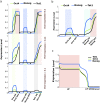Nanog, Oct4 and Tet1 interplay in establishing pluripotency
- PMID: 27146218
- PMCID: PMC4857071
- DOI: 10.1038/srep25438
Nanog, Oct4 and Tet1 interplay in establishing pluripotency
Abstract
A few central transcription factors inside mouse embryonic stem (ES) cells and induced pluripotent stem (iPS) cells are believed to control the cells' pluripotency. Characterizations of pluripotent state were put forward on both transcription factor and epigenetic levels. Whereas core players have been identified, it is desirable to map out gene regulatory networks which govern the reprogramming of somatic cells as well as the early developmental decisions. Here we propose a multiple level model where the regulatory network of Oct4, Nanog and Tet1 includes positive feedback loops involving DNA-demethylation around the promoters of Oct4 and Tet1. We put forward a mechanistic understanding of the regulatory dynamics which account for i) Oct4 overexpression is sufficient to induce pluripotency in somatic cell types expressing the other Yamanaka reprogramming factors endogenously; ii) Tet1 can replace Oct4 in reprogramming cocktail; iii) Nanog is not necessary for reprogramming however its over-expression leads to enhanced self-renewal; iv) DNA methylation is the key to the regulation of pluripotency genes; v) Lif withdrawal leads to loss of pluripotency. Overall, our paper proposes a novel framework combining transcription regulation with DNA methylation modifications which, takes into account the multi-layer nature of regulatory mechanisms governing pluripotency acquisition through reprogramming.
Figures





Similar articles
-
Reptin regulates pluripotency of embryonic stem cells and somatic cell reprogramming through Oct4-dependent mechanism.Stem Cells. 2014 Dec;32(12):3126-36. doi: 10.1002/stem.1827. Stem Cells. 2014. PMID: 25185564
-
Rinf Regulates Pluripotency Network Genes and Tet Enzymes in Embryonic Stem Cells.Cell Rep. 2019 Aug 20;28(8):1993-2003.e5. doi: 10.1016/j.celrep.2019.07.080. Cell Rep. 2019. PMID: 31433977 Free PMC article.
-
Nac1 facilitates pluripotency gene activation for establishing somatic cell reprogramming.Biochem Biophys Res Commun. 2019 Oct 15;518(2):253-258. doi: 10.1016/j.bbrc.2019.08.043. Epub 2019 Aug 12. Biochem Biophys Res Commun. 2019. PMID: 31412978
-
Role of Oct4 in maintaining and regaining stem cell pluripotency.Stem Cell Res Ther. 2010 Dec 14;1(5):39. doi: 10.1186/scrt39. Stem Cell Res Ther. 2010. PMID: 21156086 Free PMC article. Review.
-
Regulation of stem cell pluripotency and differentiation involves a mutual regulatory circuit of the NANOG, OCT4, and SOX2 pluripotency transcription factors with polycomb repressive complexes and stem cell microRNAs.Stem Cells Dev. 2009 Sep;18(7):1093-108. doi: 10.1089/scd.2009.0113. Stem Cells Dev. 2009. PMID: 19480567 Free PMC article. Review.
Cited by
-
Molecular Mechanisms Underlying Pluripotency and Self-Renewal of Embryonic Stem Cells.Int J Mol Sci. 2023 May 7;24(9):8386. doi: 10.3390/ijms24098386. Int J Mol Sci. 2023. PMID: 37176093 Free PMC article.
-
A mathematical model exhibiting the effect of DNA methylation on the stability boundary in cell-fate networks.Epigenetics. 2021 Apr;16(4):436-457. doi: 10.1080/15592294.2020.1805686. Epub 2020 Sep 22. Epigenetics. 2021. PMID: 32842865 Free PMC article.
-
Epigenetic Remodeling in Male Germline Development.Stem Cells Int. 2016;2016:3152173. doi: 10.1155/2016/3152173. Epub 2016 Oct 13. Stem Cells Int. 2016. PMID: 27818689 Free PMC article. Review.
-
NANOG is required to form the epiblast and maintain pluripotency in the bovine embryo.Mol Reprod Dev. 2020 Jan;87(1):152-160. doi: 10.1002/mrd.23304. Epub 2019 Dec 5. Mol Reprod Dev. 2020. PMID: 31803983 Free PMC article.
-
CELLoGeNe - An energy landscape framework for logical networks controlling cell decisions.iScience. 2022 Jul 14;25(8):104743. doi: 10.1016/j.isci.2022.104743. eCollection 2022 Aug 19. iScience. 2022. PMID: 35942105 Free PMC article.
References
-
- Evans M. J. & Kaufman M. H. Establishment in culture of pluripotential cells from mouse embryos. Nature 292, 154176 (1981). - PubMed
-
- Takahashi K. & Yamanaka S. Induction of pluripotent stem cells from mouse embryonic and adult fibroblast cultures by defined factors. Cell 126, 663176 (2006). - PubMed
Publication types
MeSH terms
Substances
LinkOut - more resources
Full Text Sources
Other Literature Sources
Research Materials

